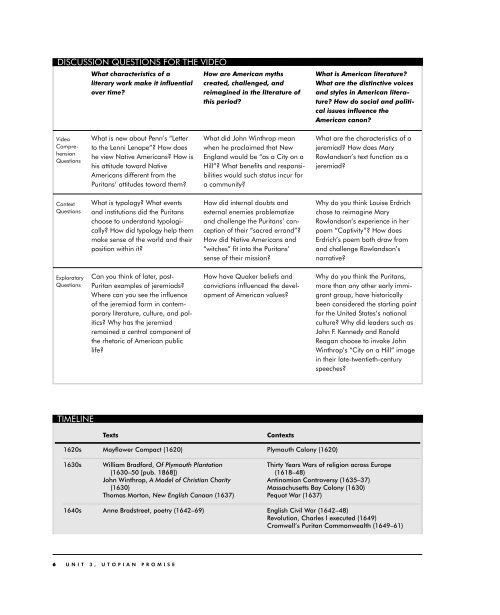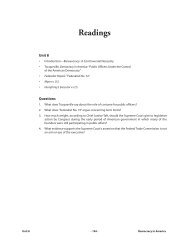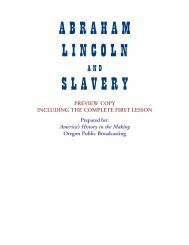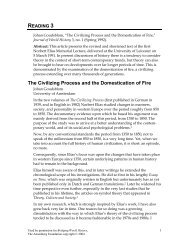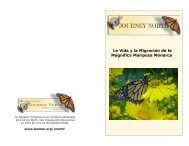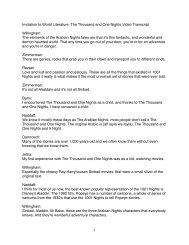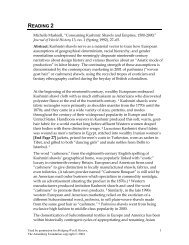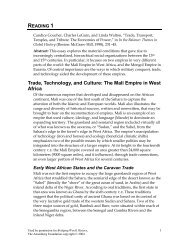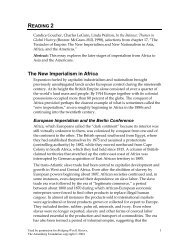UTOPIAN PROMISE - Annenberg Media
UTOPIAN PROMISE - Annenberg Media
UTOPIAN PROMISE - Annenberg Media
Create successful ePaper yourself
Turn your PDF publications into a flip-book with our unique Google optimized e-Paper software.
DISCUSSION QUESTIONS FOR THE VIDEO<br />
Video<br />
Comprehension<br />
Questions<br />
Context<br />
Questions<br />
Exploratory<br />
Questions<br />
TIMELINE<br />
What characteristics of a<br />
literary work make it influential<br />
over time?<br />
What is new about Penn’s “Letter<br />
to the Lenni Lenape”? How does<br />
he view Native Americans? How is<br />
his attitude toward Native<br />
Americans different from the<br />
Puritans’ attitudes toward them?<br />
What is typology? What events<br />
and institutions did the Puritans<br />
choose to understand typologically?<br />
How did typology help them<br />
make sense of the world and their<br />
position within it?<br />
Can you think of later, post-<br />
Puritan examples of jeremiads?<br />
Where can you see the influence<br />
of the jeremiad form in contemporary<br />
literature, culture, and politics?<br />
Why has the jeremiad<br />
remained a central component of<br />
the rhetoric of American public<br />
life?<br />
Texts Contexts<br />
1620s Mayflower Compact (1620) Plymouth Colony (1620)<br />
1630s William Bradford, Of Plymouth Plantation Thirty Years Wars of religion across Europe<br />
(1630–50 [pub. 1868]) (1618–48)<br />
John Winthrop, A Model of Christian Charity Antinomian Controversy (1635–37)<br />
(1630) Massachusetts Bay Colony (1630)<br />
Thomas Morton, New English Canaan (1637) Pequot War (1637)<br />
1640s Anne Bradstreet, poetry (1642–69) English Civil War (1642–48)<br />
Revolution, Charles I executed (1649)<br />
Cromwell’s Puritan Commonwealth (1649–61)<br />
6 UNIT 3, <strong>UTOPIAN</strong> <strong>PROMISE</strong><br />
How are American myths<br />
created, challenged, and<br />
reimagined in the literature of<br />
this period?<br />
What did John Winthrop mean<br />
when he proclaimed that New<br />
England would be “as a City on a<br />
Hill”? What benefits and responsibilities<br />
would such status incur for<br />
a community?<br />
How did internal doubts and<br />
external enemies problematize<br />
and challenge the Puritans’ conception<br />
of their “sacred errand”?<br />
How did Native Americans and<br />
“witches” fit into the Puritans’<br />
sense of their mission?<br />
How have Quaker beliefs and<br />
convictions influenced the development<br />
of American values?<br />
What is American literature?<br />
What are the distinctive voices<br />
and styles in American literature?<br />
How do social and political<br />
issues influence the<br />
American canon?<br />
What are the characteristics of a<br />
jeremiad? How does Mary<br />
Rowlandson’s text function as a<br />
jeremiad?<br />
Why do you think Louise Erdrich<br />
chose to reimagine Mary<br />
Rowlandson’s experience in her<br />
poem “Captivity”? How does<br />
Erdrich’s poem both draw from<br />
and challenge Rowlandson’s<br />
narrative?<br />
Why do you think the Puritans,<br />
more than any other early immigrant<br />
group, have historically<br />
been considered the starting point<br />
for the United States’s national<br />
culture? Why did leaders such as<br />
John F. Kennedy and Ronald<br />
Reagan choose to invoke John<br />
Winthrop’s “City on a Hill” image<br />
in their late-twentieth-century<br />
speeches?


